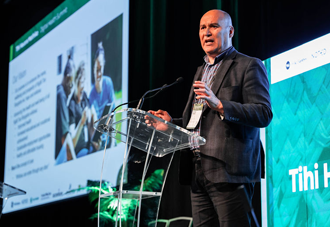Data and integration to enable mauri ora approach
Sunday, 10 March 2024
NEWS - eHealthNews.nz editor Rebecca McBeth  Te Rūnanga o Toa Rangatira is looking towards data, technology and innovation to augment their services and ensure “any door is the right door”, says tumu whakarae (chief executive) Helmut Modlik. Te Rūnanga o Toa Rangatira is looking towards data, technology and innovation to augment their services and ensure “any door is the right door”, says tumu whakarae (chief executive) Helmut Modlik.
“Our mantra is ‘any door is the right door’ requiring connection with our mauri ora ecosystem, so people have seamless access to whatever kind of help they need,” he says.
Te Rūnanga is the mandated iwi authority for Ngāti Toa Rangatira and has a holistic vision of health, “which is about doing everything we can conceive to enhance the overall wellbeing, prosperity and mana of our community”, Modlik says.
The authority is starting its journey from having an ecosystem of ad hoc applications, spreadsheets and informal processes and tools, towards standardised platforms that fit across the scope of their entire mauri ora service delivery.
It operates a number of ‘health services’ - five GP clinics, maternity, youth, and mental health and addiction services – but does not see these as distinct from others that feed into a person’s wellbeing such as food, housing and employment support services.
Modlik says they often work with whānau in a range of areas, but disconnected systems and lack of consistency meant they cannot see the whole picture of what they are delivering through their data.
You’ve read this article for free, but good journalism takes time and resource to produce. Please consider supporting eHealthNews by becoming a member of HiNZ, for just $17 a month.
Te Rūnanga o Toa Rangatira chose Noted as their key digital platform and went live in February to support a transitional housing and support service for men who have come out of prison.
“These men need a wide range of support, so this initial service implementation will provide insight into much of what we are going to encounter,” Modlik explains.
“We are working with the community to have a seamless journey, not only of service provision and support, but related data and information.”
Te Rūnanga o Toa Rangatira has also adopted the South Island regional Electronic Referral Management System (ERMS) to manage referrals in and out of the organisation.
“Our vision is to create an integrated ecosystem of comprehensive support. As people move through that integrated ecosystem, we need to have information available, such as referrals,” Modlik says.
The mauri ora approach increases the scope of what Te Rūnanga are looking to achieve with data.
“The data that we think is relevant to a person's wellbeing, or their mauri ora, is beyond the strictly physiological data,” Modlik says.
“There is also the heightened view we have around the mana and the dignity of the person and what is going on for them.”
“You can't identify root cause and come back with an optimal response, unless you have timely insights to the relevant spectrum of contributing factors.”
The community they serve has a disproportionately complex set of multifactorial comorbidities, so it is “never going to be realistic for us to expect our teams to be across an ever growing pool of data”, he explains.
“Our vision is that we will be able to utilise emerging tools for decision support, and that is occurring in a holistic frame.”
Modlik says the frame of thinking about people holistically excludes the fragmented siloed thinking and approach which characterises much of the rest of the health and social service system.
“We are best placed to accumulate evidence for what is possible when you integrate and pursue the vision we were describing. It is just the beginning, but we are optimistic.”
Picture: Helmut Modlik speaking at the Tihi Hauora Matihiko
To comment on or discuss this news story, go to the eHealthNews category on the HiNZ eHealth Forum
Read more Interoperability news
Return to eHealthNews.nz home page
|